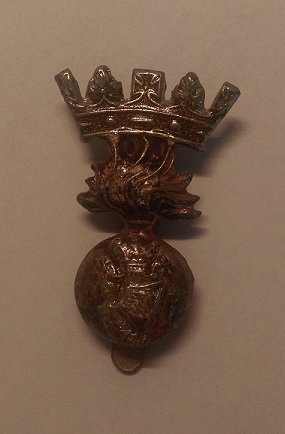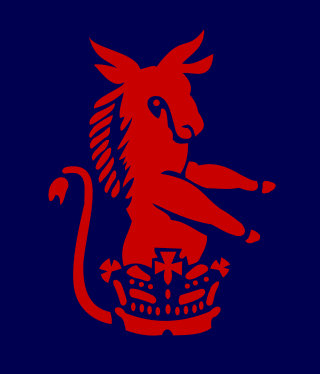Related Research Articles

The 16th (Irish) Division was an infantry division of the British Army, raised for service during World War I. The division was a voluntary 'Service' formation of Lord Kitchener's New Armies, created in Ireland from the 'National Volunteers', initially in September 1914, after the outbreak of the Great War. In December 1915, the division moved to France, joining the British Expeditionary Force (BEF), under the command of Irish Major General William Hickie, and spent the duration of the war in action on the Western Front. Following enormous losses at the Somme, Passchendaele and Ypres, the 16th (Irish) Division required a substantial refit in England between June and August 1918, which involved the introduction of many non-Irish battalions.

The 4th Infantry Division was a regular infantry division of the British Army with a very long history, seeing active service in the Peninsular War and Waterloo Campaign, the Crimean and Boer Wars and both World Wars. It was disbanded after the Second World War and reformed in the 1950s as an armoured formation before being disbanded and reformed again and finally disbanded on 1 January 2012.

The Royal Irish Rifles was an infantry rifle regiment of the British Army, first created in 1881 by the amalgamation of the 83rd Regiment of Foot and the 86th Regiment of Foot. The regiment saw service in the Second Boer War, the First World War, the Second World War, and the Korean War.

The Royal Inniskilling Fusiliers was an Irish line infantry regiment of the British Army in existence from 1881 until 1968. The regiment was formed in 1881 by the amalgamation of the 27th (Inniskilling) Regiment of Foot and the 108th Regiment of Foot.

The 7th Canadian Infantry Division was an infantry division of the Canadian Army, mobilized in the spring of 1942 and assigned for home defence within Atlantic Command, during World War II.

The 38th (Irish) Brigade, is a brigade formation of the British Army that served in the Second World War. It was composed of North Irish line infantry regiments and served with distinction in the Tunisian and Italian Campaigns. Following the end of the war, the brigade was disbanded, but was reformed in sixty years later in 2007 and remains the regional formation for Northern Ireland.

The 49th Infantry Brigade, later known as 49th (Eastern) Infantry Brigade during the Cold War, was a brigade of the British Army.

The 14th Indian Infantry Division was an infantry division of the Indian Army during World War II. It fought in the Arakan Campaign 1942–43, and was subsequently converted into a Training Division, providing drafts of replacements for units of the Fourteenth Army during the Burma Campaign.

The 210th Independent Infantry Brigade (Home) was an infantry brigade formation of the British Army organised during the Second World War to command a group of newly raised Home Defence battalions. It was later converted to a frontline brigade that served (under a new name) with distinction in the later years of the war, the 38th (Irish) Infantry Brigade.

The Royal Irish Fusiliers (Princess Victoria's) was an Irish line infantry regiment of the British Army, formed by the amalgamation of the 87th (Prince of Wales's Irish) Regiment of Foot and the 89th (Princess Victoria's) Regiment of Foot in 1881. The regiment's first title in 1881 was Princess Victoria's (Royal Irish Fusiliers), changed in 1920 to the Royal Irish Fusiliers (Princess Victoria's). Between the time of its formation and Irish independence, it was one of eight Irish regiments.

The 31st Infantry Brigade was an infantry formation of the British Army, which participated in both the First and the Second World Wars. The brigade was later reformed after the end of the war serving in the British Army of the Rhine until the end of National Service in 1956, which saw the reorganisation of the brigade as the 11th Infantry Brigade.
The 47th Brigade was a formation of British Army. It was part of the new army also known as Kitchener's Army. It was assigned to the 16th (Irish) Division and served on the Western Front during the First World War. Philip Miles of the Indian Army briefly commanded this brigade.
The 45th Infantry Brigade was an infantry brigade of the British Army that saw active service in both the First and the Second World Wars with 15th (Scottish) Infantry Division.
The 48th Brigade was a brigade of the British Army.
The 96th Brigade was a formation of the British Army during the First World War. It was raised as part of the new army also known as Kitchener's Army and assigned to the 32nd Division. The brigade served on the Western Front.
The 198th Brigade was an infantry brigade of the British Army that saw service during the First World War with the 66th Division. It was reformed in the Second World War as the 198th Infantry Brigade and served with 54th Infantry Division, where it remained in the United Kingdom throughout the war and was disbanded in late 1943.
The 113th Brigade was an infantry brigade formation of the British Army active in both the First and the Second World Wars.
References
- ↑ "16th (Irish) Division". The Long Long Trail. Retrieved 20 January 2012.